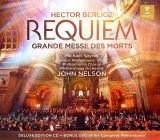 Hector Berlioz: Grande Messe des Morts (Requiem); Michael Spyres, Tenor, Philharmonia Chorus, London Philharmonic Choir, Philharmonia Orchestra, John Nelson; 1 CD & 1 DVD Erato 9029543064; Liveaufnahme 03/2019, Veröffentlichung 09/2019 (2x ca 80') – Rezension von Remy Franck
Hector Berlioz: Grande Messe des Morts (Requiem); Michael Spyres, Tenor, Philharmonia Chorus, London Philharmonic Choir, Philharmonia Orchestra, John Nelson; 1 CD & 1 DVD Erato 9029543064; Liveaufnahme 03/2019, Veröffentlichung 09/2019 (2x ca 80') – Rezension von Remy Franck
Zum 150. Todestag von Hector Berlioz dirigierte John Nelson in der Londoner St Paul’s Cathedral die Grande Messe des Morts mit dem Philharmonia Orchestra, dessen Chor sowie dem London Philharmonic Choir. Es ist dies eine großartige Aufführung, so wie man sie von einem der kompetentesten Berlioz-Dirigenten unserer Tage erwarten durfte. Chöre und Orchester gelangen unter seiner einfühlsamen Leitung zu einer außerordentlich tiefschürfenden, packenden Interpretation. Auch von Michael Spyres, der das Tenorsolo im Sanctus übernommen hatte, kann nur Positives gesagt werden.
Allerdings bleibt die Aufnahme trotz einer doch erstaunlich erfolgreichen Mikrophonierung ein Opfer der Akustik, weil es an Transparenz und Konturen fehlt. Das wird freilich durch die besonderen Umstände und die daraus erwachsende Inspiration aller Beteiligten wettgemacht.
Ein weiterer Bonus dieser Produktion ist, dass neben der Audio-CD auch die Videoaufnahme des Konzerts auf DVD mitgeliefert wird. Da kommt dann zum zweifellos großen Eindruck, den die Musik hinterlässt, das visuelle Element hinzu, mit einer einfallsreichen, lebendigen Kameraführung und zum Teil spektakulären Kameraeinstellungen.
Die CD wiederum hat den Vorteil einer besseren Postproduktion. Mir scheint als hätten die Produzenten den Klang der Videoaufnahme etwas anders bearbeitet als den der CD. In jedem Fall ist der diskrete Surround-Sound dem Höreindruck förderlich, weil er das zwar weniger präzise Klangbild räumlich dem Bild anpasst.
On the 150th anniversary of Hector Berlioz’s death, John Nelson conducted the Grande Messe des Morts at London’s St Paul’s Cathedral with the Philharmonia Orchestra, its choir and the London Philharmonic Choir.
It is a great performance, as one could expect from one of the most competent Berlioz conductors. Under Nelson’s sensitive direction choirs and orchestra achieve an extraordinarily profound and gripping interpretation. Michael Spyres, the tenor in the Sanctus, is a characterful soloist.
However, despite an astonishingly successful recording technique, the sound suffers from the acoustics of the church, lacking transparency and contours. Of course, this is compensated by the special circumstances and the resulting inspiration of all participants.
A further bonus of this production is that, in addition to the audio CD, the video recording of the concert is also supplied on DVD. The visual element with an imaginative, lively camera work and sometimes spectacular shots undoubtedly adds a lot to the great impression left by the music.
The CD, on the other hand, has the advantage of a better post-production. It seems to me that the producers edited the sound of the video recording somewhat differently from that of the CD. In any case, the discrete surround sound is favourable to the listening impression, because it adapts the less precise sound to what we see.






















